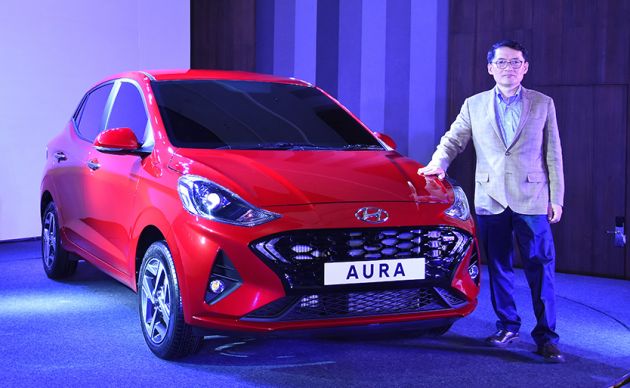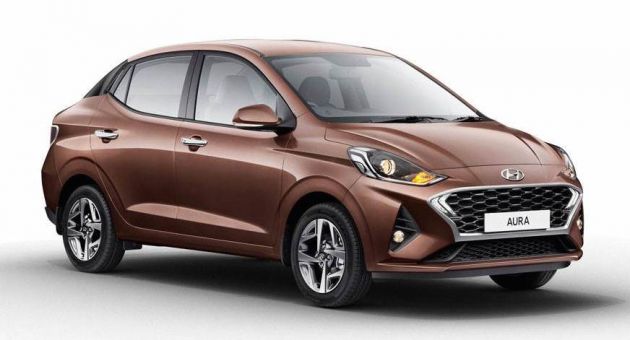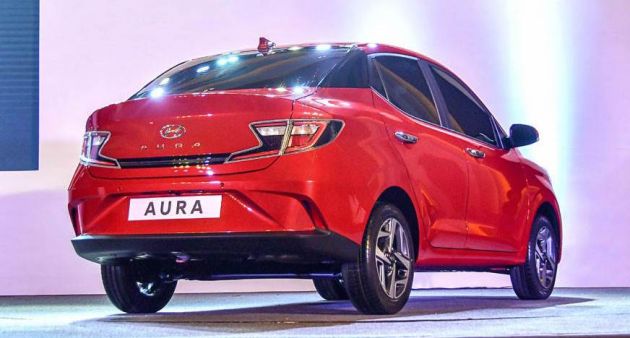Hyundai has revealed the new Aura sedan for the Indian market. The Aura is a small booted version of the Grand i10 Nios hatchback, which is India’s version of the latest generation i10 A-segment hatch. While it’s a natural replacement for the Hyundai Xcent, a sedan based on the previous-gen i10, local reports mention that the Xcent will continue to be sold to fleets.
Recently previewed in India ahead of an official launch on January 21, 2020, the Hyundai Aura is a typical Indian sub-4m sedan with a stunted boot to dodge under the length limit, for tax reasons. Every serious player in India has got to have one of these in the range – among the Aura’s rivals are the Maruti Dzire (based on Swift), the Honda Amaze (based on Brio), Ford Aspire and Tata Tigor.
The Aura measures 3,995 mm long, 1,680 mm wide and 1,520 mm tall, with a 2,450 mm wheelbase. The boot volume is a rather large 402 litres, and Hyundai claims to have the best optimisation of legroom and boot space – there’s only so much length to play around with after all.
The Aura is very clearly related to the Grand i10 Nios from the front, but closer inspection reveals a slightly different bumper and grille. The big “mouth” gets a gloss black honeycomb insert with “Twin Boomerang” LED daytime running lights. The i10 gets one on each end of the grille. More flash comes in the form of blade-style two-tone 15-inch alloys.
Moving on, there’s a black strip on the C pillars to create the “floating roof” effect, while the rear end sees the tail lamps (Z-shaped LEDs) visually connected, in the style of the very bold eighth-gen Sonata that was revealed earlier this year. Like the D-segment sedan, the model name is spelled out in the middle of the rear. Overall, the design is rather edgy with many sharp elements.
The Aura will be offered with three BS-6 (India’s latest emissions standard) engines, including a first-in-class 100 hp/172 Nm 1.0 litre turbo engine. The 1.0L T-GDI petrol unit’s compact layout is from integrating the exhaust manifold to the cylinder head, which also improves fuel efficiency higher up the rev range, Hyundai says.
Besides that, there’s also a naturally aspirated 1.2 litre MPI Kappa petrol engine with 83 hp/114 Nm, and a new 1.2 litre Ecotorq diesel with 75 hp/190 Nm. The Korean carmaker says that the oil burner comes with a 2,000 bar fuel injection system and a crankshaft bearing with optimised thickness and material to reduce friction. Both these engines can be had with a five-speed manual or AMT gearbox, but the 1.0T is manual-only.
Hyundai also claims a body structure with 65% advance high strength steel, “best ride and handling performance” and 7,500 km of evaluation across India to assess reliability on diverse road and climate conditions.
The Korean brand is determined to outkit the competition with the Aura. Segment first features include a wireless charger, driver rear view monitor, chrome outside door handles, a leather wrapped gear knob, eco coating, emergency stop signal and air curtain. Things quoted as best in class include a 5.3-inch digital speedo and multi-info display, 8.0-inch touchscreen head unit with Android Auto and Apple CarPlay, Arkamys sound and projector fog lamps.
The Aura’s interior was not shown at the media preview, but it would probably not differ much from the dashboard of the Grand i10 Nios.
Source: Read Full Article



